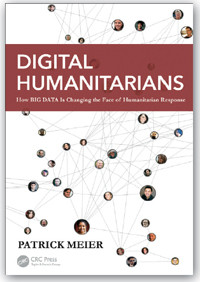
Digital Humanitarians: How "Big Data" is Changing the Face of Humanitarian Response
Patrick Meier
187 pages, Taylor and Francis Press, 2015
We humans have been helping other humans ever since we first walked upright. For most of the subsequent millennia, proximity has determined how much help we could provide in any given situation. Over the past century and a half, technologies that range from the telegraph to the airplane have expanded the reach of our response. But how and when we could respond to a crisis still depended on how near we were to it. Over the past half-decade, however, our ability to help others has begun to escape the constraints of time and distance.
That’s because new technologies—from ever-ready digital sensors to social network platforms, from smartphones to readily available satellite imagery—are making the world an ever-more-connected place. Some have likened the result of this expansion of digital connectivity to a global circulatory system. In Digital Humanitarians, Patrick Meier suggests a different anatomical metaphor: He posits the emergence of a new “nervous system” in which billions of people are able to contribute information to a shared network of digital data.
The book covers many different technologies, but they share two critical characteristics: They generate digital data, and they extend almost everywhere. Meier argues that access to these technologies helps us to be more humane. They help us reach out, offer assistance, contribute our skills, and extend the scope of our compassion. All around the world, people are using the resources at hand—high-skilled data expertise, free social media accounts, expensive satellite imagery, off-the-shelf drones—to help in moments of crisis. In the book, Meier recounts the successes, failures, and hard-won lessons of this dispersed group of risk-taking innovators.
Meier himself has spent the past five years working with others to deploy digital tools in almost every kind of disaster. When an earthquake struck Haiti in 2010, he was in Boston and his fiancée was in Port-au-Prince. The stress of not hearing from her led him to begin collecting news reports, text messages, and tweets about the situation in Haiti. To gather those disparate bits of information into a single picture, he organized them using an online map. He then recruited volunteers from his personal network, and they jumped in to help him manage the flow of digital data.
Other humanitarian crises followed—an earthquake in Chile, a fire in Russia, a revolution in Libya, political unrest in Kyrgyzstan, a super-storm in the United States. Far-flung volunteers like Meier mounted a digital response to each of these events. In many cases, participants in one eff ort laid the groundwork for those who stepped forward to help in another crisis. The digital output of each event (crisis maps, crowdsourcing platforms, FAQs) became fodder for the next action. This cycle of adopting a tool, adapting it to a task, and then moving on to the next challenge is a central feature of digital humanitarianism.
Meier’s loose-knit network eventually turned into the Standby Task Force, a group of volunteers who remained on call to help with mapping, social media filtering , and other urgent digital chores. The group honed its use of crowdsourcing and microtasking (breaking tasks such as tagging photos into a series of one-click actions). The upshot of these efforts was a resilient, remarkably powerful, “always-on” network that could sift through huge streams of tweets or text messages. In time, the Standby Task Force evolved into Digital Humanitarian Network, a more structured entity that focuses on complementing the work and extending the reach of various UN and NGO partners.
In tracing the rapid development of digital humanitarian action, Meier tells a story that matters to all of civil society. At first, the new digital humanitarians met with skepticism and resentment from established humanitarian organizations. In five short years, the two parties sprinted through several stages—combative distrust, arrogant dismissiveness, hesitant collaboration—before reaching a point where they can pursue shared goals in a spirit of co-creation. It has been neither easy nor pain-free. But every segment of the social sector is going through some version of this story, and every one in the sector can learn something from Meier’s account.
The best parts of Digital Humanitarians are those that show how humanitarian institutions, independent volunteers, and leading digital companies reinforce each other’s efforts. The tale that Meier tells is one of complementarity: Digital humanitarians are not replacing established aid organizations or government agencies. Instead, humanitarian aid has become a dynamic ecosystem that encompasses amateurs and experts, one-off participants and long-term professionals, drone operators and satellite imagery analysts. The global digital “nervous system” provides the context in which they do their work.
This emerging system is also a source of new and pressing challenges. The use of digital tools to serve humanitarian goals—often by volunteers or for-profit businesses with an informal commitment to humanitarian work—raises critical ethical questions and creates a need to establish new codes of conduct. Meier’s most compelling contribution, in short, is to demonstrate that we must develop a policy framework for humanitarian action that assumes a digital context.

